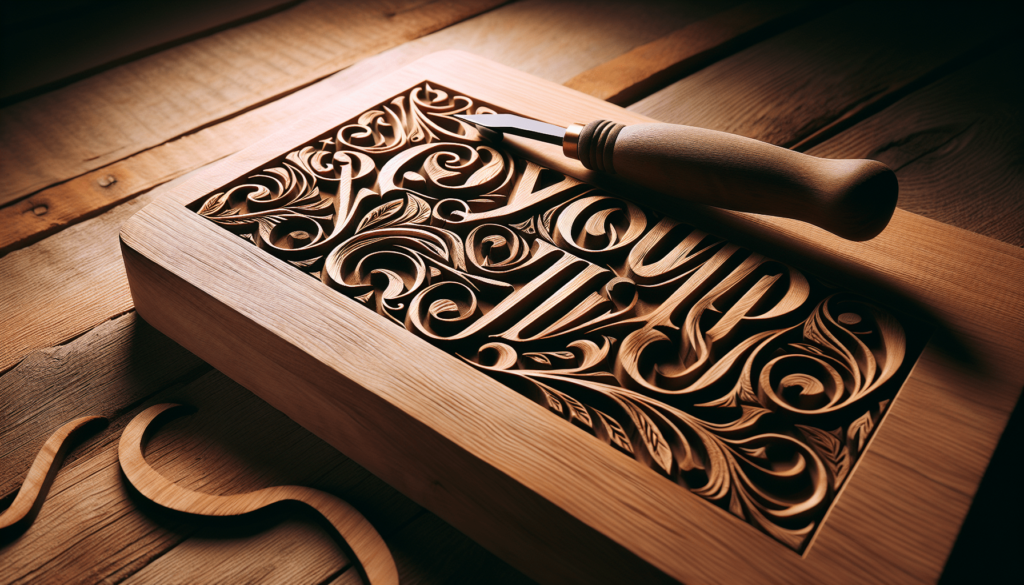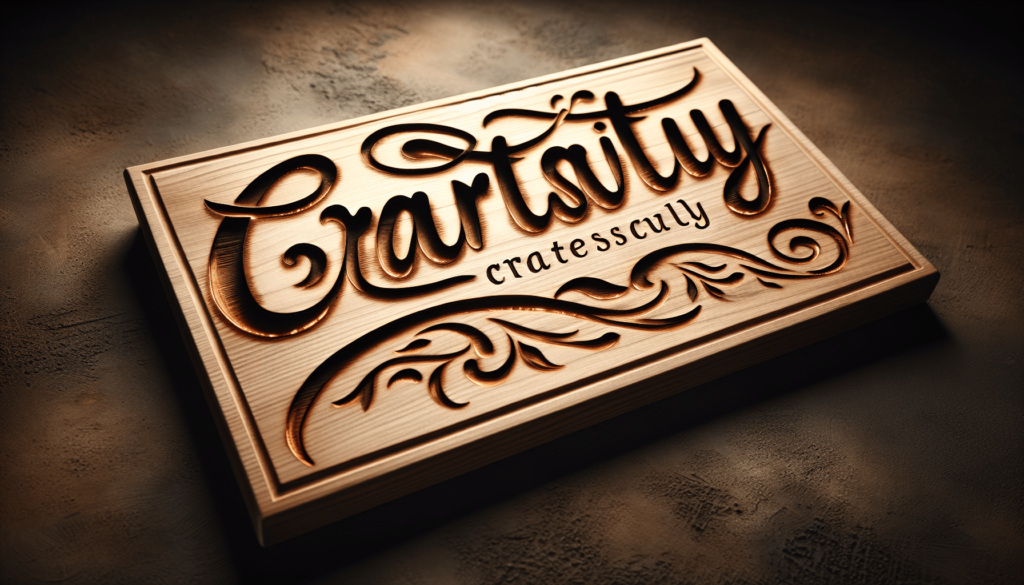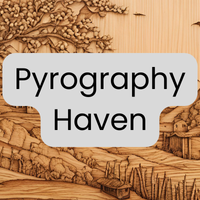Have you ever wondered how you might burn letters into wood without the use of traditional tools? It’s one of those quirky skills that sounds like it could range from a fun pastime to a survivalist technique I’d boast about at a dinner party. The beauty of this task is not only in its potential artistry but also in the challenge of accomplishing it with nothing more than what you probably have at home on a lazy Sunday.
Now, I imagine you’re skeptical. How am I going to achieve such an artistic feat without my trusty wood-burning pen or a laser engraver, you ask? Well, let me assure you, where there’s a will (and a healthy dose of curiosity), there’s a way. So, pull up a chair or maybe settle onto a comfortable mat beside a makeshift workshop, and let’s embark on this surprisingly grounding craft experience together.

Understanding the Basics of Wood Burning
Why Burn Letters Into Wood?
Beneath every craft project lies the “why,” the often sentimental or practical reason we choose one artistic adventure over another. The process of burning letters into the wood serves both functional and decorative purposes. Imagine crafting a personalized cutting board or a sign for your garden — quirky yet subtly sophisticated!
History of Wood Burning
Diving into a bit of history always sets the mood. Pyrography, or wood burning, has floated through centuries. From its roots in ancient Egypt and China, where artisans used hot metal rods to decorate wood and leather, to its rise as a popular hobby in the Victorian era, wood burning has evolved, transcending barriers of culture and class, and landing back in comfy homes like yours and mine.
Experimenting with Basic Household Supplies
Finding the Right Wood
It turns out, not all wood is created equal when it comes to burning designs. Softer woods, such as pine or basswood, allow for more straightforward manipulation — think of them as the beginner level in a complex video game. If deep, dramatic lines are more your style, opting for hardwoods like oak could be your path.
Preparing Your Workspace
When embarking on this medieval journey, it’s a wise idea to stake out a space that feels both inspirational and practical. Perhaps a large, flat surface or a corner of your garden under the morning sun? Just steer clear of anything precious that could scorch, like a Persian rug or your grandmother’s lace tablecloth.
Stencils and Design Templates
Even before wood meets flame, consider your design’s layout. Sometimes just doodling your intentions first can save a world of accidental artistic blunders. Using stencils or templates simplifies the process, particularly for wordy projects. Opt for letters that echo your personality: curly, capital, cursive, or bold — the world (and by extension, your selected wood) is your oyster.
The Art of Using Fire’s Simpler Tools
Magnifying Glass on a Sunny Day
Yes, the age-old science fair concept where you use a magnifying glass to direct a sunbeam into a concentrated point, thereby creating enough heat to etch into wood. With a steady hand and a clear, sunny day, letters can slowly take form as you guide the focused beam along planned curves and lines. Be cautious, though! It’s as much a test of patience as it is of fire safety.
Baking Soda and a Heat Source
There’s an eerily satisfying chemistry experiment here: creating a paste of baking soda mixed with water and applying it to your intended design. Once dried, a heat source like a hairdryer or oven can be used to ‘bake’ the wood. This method colors and stains the wood naturally — a kind of magic trick, if you will. Imagine the tales you could spin from such backyard alchemy!
The Vinegar and Rusty Nail Technique
Let’s step into a slightly messier realm. Combining vinegar and rusted nails creates an oxidizing solution. Over time (think of it as a trickle-through-art experience), this concoction stains the wood in designs drawn with patience and anticipation of results that often stray into the realm of unpredictable beauty.
Techniques and Patience: A Friendship Forged in Fire
Creating a Prep-It-Yourself Stencil
While adaptation is key, nothing beats a personal touch. You can create custom stencils using thick paper or lightweight cardboard and a trusty pair of scissors. Map out your desired designs, or print them if freehand seems a commitment your nerves cannot allow.
Practicing the Art of Steady Hands
There’s a certain delightful anxiety in realizing just how wobbly my hands can get when tasked with precision. Developing a steady hand requires practice and, sooner or later, even a certain poetic tranquility — imagine your calm guiding you through the fine loops of an “l” or the swoops of a “g.”
The Right Amount of Heat
Applying the right amount of heat can be the difference between a perfect mark and a blemish. It’s very much a process of trial and error. Too much heat, and you’ll scorch your hard work (or set your kitchen table on fire — a lesson I’ve learned the hard way); too little, and nothing happens. Finding balance could just be the lesson we didn’t know we needed.

Mastering the Craft: Tips and Tricks
Marking Mistakes and Fixes
My early efforts at lettering drove home the importance of patience. Mistakes are inevitable, but learning clever fixes, like sanding rough edges or lightly staining the whole piece to hide blemishes, quickly turns mishaps into secret ingredients of personal growth. I found humor in my efforts, offering up increasingly asked-for anecdotes.
Sealing and Preserving Your Work
Once those letters are finally burned with success, I’d wager you’d want to keep it that way. Sealing the wood can reinforce its durability while deepening the colors of the burn marks. Natural oils, beeswax, or varnish can act as custodian to your creation, ensuring both beauty and longevity.
Sharing the Joy of a Simple Project
I learned to appreciate how a small project offered so much quiet joy. Sharing your creation need not be limited to social media platforms. Friends welcomed them as gifts, while family members would secretly covet them, wondering if they have a stake in my newfound artistic side.
The Joys (and Trials) of Creativity Without Tools
The Freedom of Limitation
Why tether creativity to a strict frame? There’s a rebellious delight in freeing yourself from overreliance on tools. Crafting letters into wood without traditional instruments reminds the artistic adventurer inside us to explore how limitations can spark unexpected innovations.
Embracing Imperfection
There’s beauty in acknowledging imperfection as part of the narrative. Each uneven line or slightly charred edge contributes to the human touch, something impossible to replicate with a flawless machine engraving.
Building Patience Like a Fine Table
Burning letters into wood requires patience as much as it requires creativity. Through mistakes and mishaps, I found a certain calm. Was it simply the pleasure of creating with my hands, or was it the slow-burning realization that sometimes, we need life to slow its frantic pace?
Transforming Your New Skill: Practical Applications and Big Dreaming
Unique Home Decorations
Imagine the sighs of envy when visitors notice handmade signs in the kitchen or personalized room markers scattered throughout the house. Creating custom coasters, plaques, or table markers adds a rustic charm. Transformation fuels imagination.
Personalized Gifts
A wooden plaque with someone’s favorite quote or a initials-burnt cutting board can elevate gifting to new heights. The time invested in burnishing that dedication means more than a standard gift card ever could.
Building a Small Business Out of Nothing
What if wood burning became more than just a Sunday hobby? Perhaps it’s the start of a small Etsy shop, or maybe just word-of-mouth commissions within your community. Making life’s passion into payable skill isn’t just a daydream. Sometimes, realism has a way of extending your imagined horizon.
Conclusion: Letting the Embers Guide Us
So there we are, you and I — kindred spirits in the art of burning letters into wood without tools. There’s an unexpected journey to be found in these small acts of artistry, one where the pathway matters as much as the destination. Through tiny victories and joyous mishaps, there’s always a reminder that creativity has no fixed formula. Sometimes, all it takes is the sun’s warmth, a touch of baking soda, household staples, and most importantly, the eagerness to try out something entirely unconventional.
Next time the sun is high, I might just step out with a magnifying glass and some scrap wood, ready to create, eager to inspire, and prepared for those inevitable blunders that will define the character of my work — each burn mark whispering a story worth telling at the dinner table.

